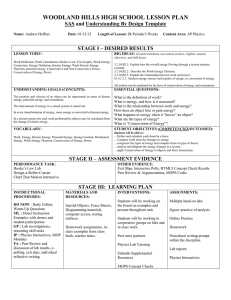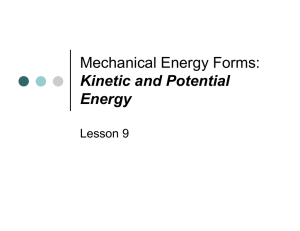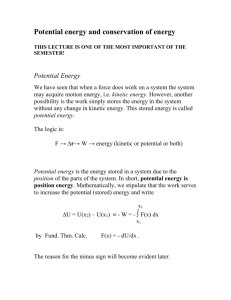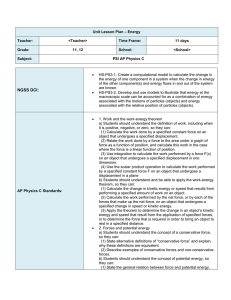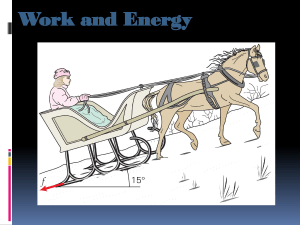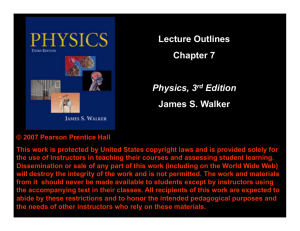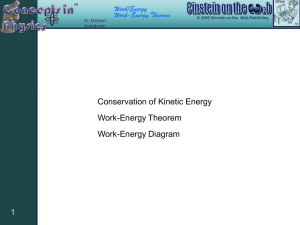Chapters 7-8 (Energy)
advertisement
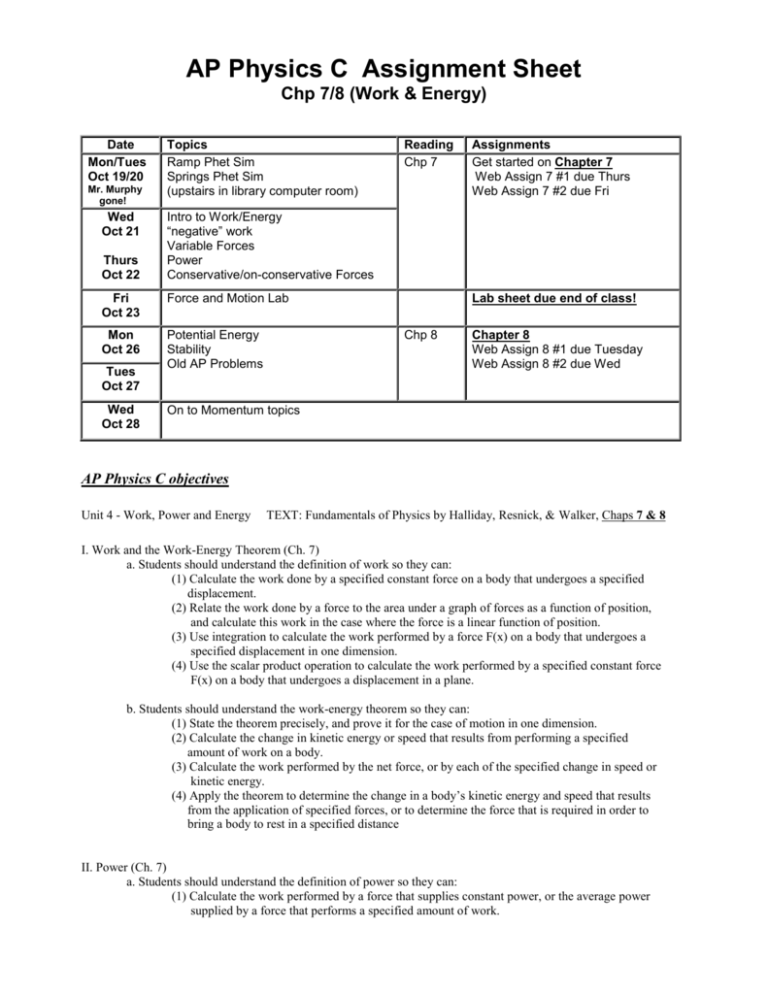
AP Physics C Assignment Sheet Chp 7/8 (Work & Energy) Date Mon/Tues Oct 19/20 Mr. Murphy gone! Wed Oct 21 Thurs Oct 22 Topics Ramp Phet Sim Springs Phet Sim (upstairs in library computer room) Force and Motion Lab Mon Oct 26 Potential Energy Stability Old AP Problems Wed Oct 28 Assignments Get started on Chapter 7 Web Assign 7 #1 due Thurs Web Assign 7 #2 due Fri Intro to Work/Energy “negative” work Variable Forces Power Conservative/on-conservative Forces Fri Oct 23 Tues Oct 27 Reading Chp 7 Lab sheet due end of class! Chp 8 Chapter 8 Web Assign 8 #1 due Tuesday Web Assign 8 #2 due Wed On to Momentum topics AP Physics C objectives Unit 4 - Work, Power and Energy TEXT: Fundamentals of Physics by Halliday, Resnick, & Walker, Chaps 7 & 8 I. Work and the Work-Energy Theorem (Ch. 7) a. Students should understand the definition of work so they can: (1) Calculate the work done by a specified constant force on a body that undergoes a specified displacement. (2) Relate the work done by a force to the area under a graph of forces as a function of position, and calculate this work in the case where the force is a linear function of position. (3) Use integration to calculate the work performed by a force F(x) on a body that undergoes a specified displacement in one dimension. (4) Use the scalar product operation to calculate the work performed by a specified constant force F(x) on a body that undergoes a displacement in a plane. b. Students should understand the work-energy theorem so they can: (1) State the theorem precisely, and prove it for the case of motion in one dimension. (2) Calculate the change in kinetic energy or speed that results from performing a specified amount of work on a body. (3) Calculate the work performed by the net force, or by each of the specified change in speed or kinetic energy. (4) Apply the theorem to determine the change in a body’s kinetic energy and speed that results from the application of specified forces, or to determine the force that is required in order to bring a body to rest in a specified distance II. Power (Ch. 7) a. Students should understand the definition of power so they can: (1) Calculate the work performed by a force that supplies constant power, or the average power supplied by a force that performs a specified amount of work. (2) Prove that the relation P = F • v follows from the definition of work, and apply this relation in analyzing particle motion. III. Conservative Forces and Potential Energy (Ch. 8) a. Students should understand the concept of a conservative force so they can: (1) State two alternative definitions of “conservative force”, and explain why these definitions are equivalent. (2) Describe two examples each of conservative forces and non-conservative forces. (2) Calculate a potential energy function associated with a specified one-dimensional force F(x). (3) Given the potential energy function U(x) for a one-dimensional force, calculate the magnitude and direction of the force. (4) Write an expression for the force exerted by and ideal spring and for the potential energy stored in a stretched or compressed spring. (5) Calculate the potential energy of a single body in a uniform gravitational field. (6) Calculate the potential energy of a system of bodies in a uniform gravitational field. (7) State the generalized work-energy theorem and use it to relate the work done by nonconservative forces on a body to the changes in kinetic and potential energy of the body. IV. Conservation of Energy (Ch. 8) a. Students should understand the concepts of mechanical energy and of total energy so they can: (1) State, prove, and apply the relation between the work performed on a body by non-conservative forces and the change in a body’s mechanical energy. (2) Describe and identify situations in which mechanical energy is converted to other forms of energy. (3) Analyze situations in which a body’s mechanical energy is changed by friction or by a specified externally applied force. b. Students should understand conservation of energy so they can: (1) Identify situations in which mechanical energy is or is not conserved. (2) Apply conservation of energy in analyzing the motion of bodies that are moving in a gravitational field and are subject to constraints imposed by strings or surfaces. (3) Apply conservation of energy in analyzing the motion of bodies that move under the influence of springs. (4) Apply conservation of energy in analyzing the motion of bodies that move under the influence of other specified one-dimensional forces. c. Students should be able to recognize and solve problems that call for application both of conservation of energy and Newton’s Laws
